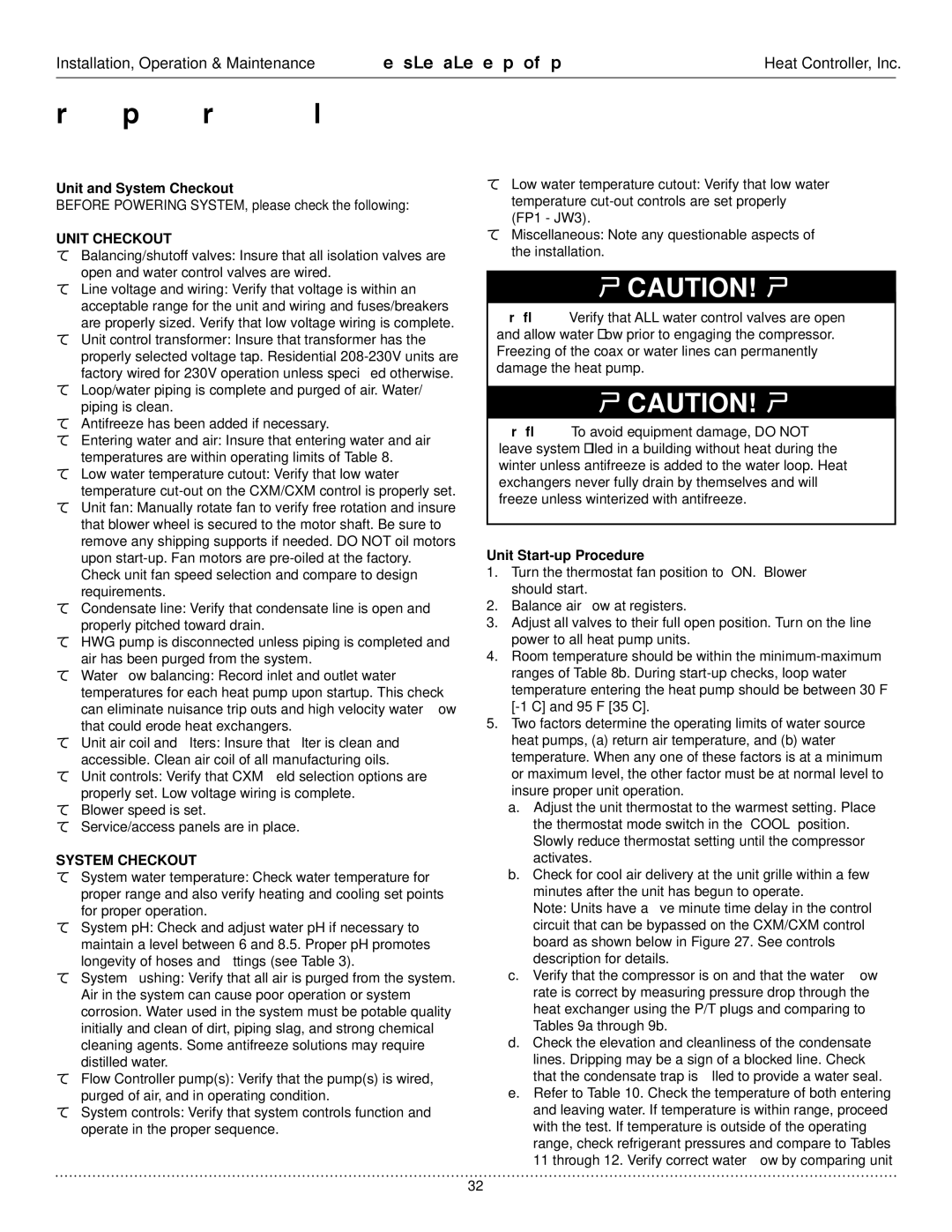
Installation, Operation & Maintenance | HTV/HTD/HTH SERIES | Heat Controller, Inc. |
Unit Start-Up and Operating Conditions
Unit and System Checkout
BEFORE POWERING SYSTEM, please check the following:
UNIT CHECKOUT
Balancing/shutoff valves: Insure that all isolation valves are open and water control valves are wired.
Line voltage and wiring: Verify that voltage is within an acceptable range for the unit and wiring and fuses/breakers are properly sized. Verify that low voltage wiring is complete. Unit control transformer: Insure that transformer has the properly selected voltage tap. Residential
Antifreeze has been added if necessary.
Entering water and air: Insure that entering water and air temperatures are within operating limits of Table 8.
Low water temperature cutout: Verify that low water temperature
Condensate line: Verify that condensate line is open and properly pitched toward drain.
HWG pump is disconnected unless piping is completed and air has been purged from the system.
Water flow balancing: Record inlet and outlet water temperatures for each heat pump upon startup. This check can eliminate nuisance trip outs and high velocity water flow that could erode heat exchangers.
Unit air coil and filters: Insure that filter is clean and accessible. Clean air coil of all manufacturing oils.
Unit controls: Verify that CXM field selection options are properly set. Low voltage wiring is complete.
Blower speed is set. Service/access panels are in place.
SYSTEM CHECKOUT
System water temperature: Check water temperature for proper range and also verify heating and cooling set points for proper operation.
System pH: Check and adjust water pH if necessary to maintain a level between 6 and 8.5. Proper pH promotes longevity of hoses and fittings (see Table 3).
System flushing: Verify that all air is purged from the system. Air in the system can cause poor operation or system corrosion. Water used in the system must be potable quality initially and clean of dirt, piping slag, and strong chemical cleaning agents. Some antifreeze solutions may require distilled water.
Flow Controller pump(s): Verify that the pump(s) is wired, purged of air, and in operating condition.
System controls: Verify that system controls function and operate in the proper sequence.
Low water temperature cutout: Verify that low water temperature
Miscellaneous: Note any questionable aspects of the installation.
CAUTION!
CAUTION! Verify that ALL water control valves are open and allow water flow prior to engaging the compressor. Freezing of the coax or water lines can permanently damage the heat pump.
CAUTION!
CAUTION! To avoid equipment damage, DO NOT leave system filled in a building without heat during the winter unless antifreeze is added to the water loop. Heat exchangers never fully drain by themselves and will freeze unless winterized with antifreeze.
Unit Start-up Procedure
1.Turn the thermostat fan position to “ON.” Blower should start.
2.Balance air flow at registers.
3.Adjust all valves to their full open position. Turn on the line power to all heat pump units.
4.Room temperature should be within the
5.Two factors determine the operating limits of water source heat pumps, (a) return air temperature, and (b) water temperature. When any one of these factors is at a minimum or maximum level, the other factor must be at normal level to insure proper unit operation.
a.Adjust the unit thermostat to the warmest setting. Place the thermostat mode switch in the “COOL” position. Slowly reduce thermostat setting until the compressor activates.
b.Check for cool air delivery at the unit grille within a few minutes after the unit has begun to operate.
Note: Units have a five minute time delay in the control circuit that can be bypassed on the CXM/CXM control board as shown below in Figure 27. See controls description for details.
c.Verify that the compressor is on and that the water flow rate is correct by measuring pressure drop through the heat exchanger using the P/T plugs and comparing to Tables 9a through 9b.
d.Check the elevation and cleanliness of the condensate lines. Dripping may be a sign of a blocked line. Check that the condensate trap is filled to provide a water seal.
e.Refer to Table 10. Check the temperature of both entering and leaving water. If temperature is within range, proceed with the test. If temperature is outside of the operating range, check refrigerant pressures and compare to Tables 11 through 12. Verify correct water flow by comparing unit
32
